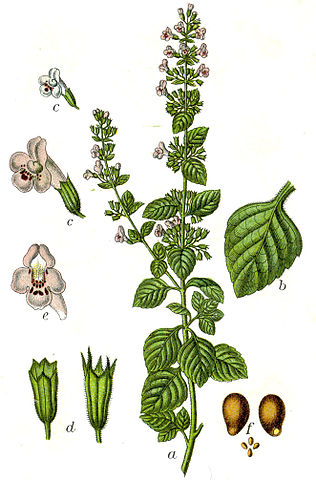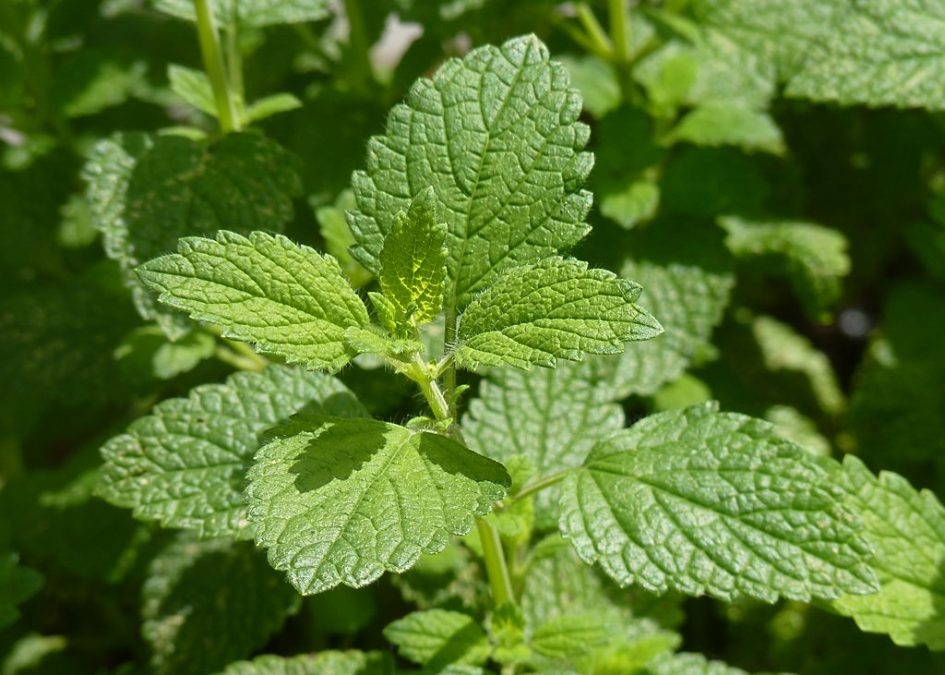
Lemon Balm By Johann Georg Sturm (Painter: Jacob Sturm) [Public domain], via Wikimedia Commons
Let Your Stress Melt Away with Lemon Balm
Next time you’re stressed or anxious, try turning to a medicinal herb called Melissa officinalis, commonly known as lemon balm. This wonderful lemony smelling, bushy perennial plant is native to the eastern Mediterranean Region and western Asia but is now cultivated world-wide. Traditionally this herb has been used as medicine to treat a wide variety of diseases (Shakeria et al 2016). The chemical properties of the plant, when ingested or inhaled, have relaxing effects on the body among numerous other health benefits like easing stomach pains, promoting sleep, antiviral, and antispasmodic properties (Moradkhani et al. 2010). The essential oil made from lemon balm is high in compounds called triterpenes, which are rapidly absorbed through the lungs and have a calming effect on the body through aroma therapy. Essential oil created from the leaves can also eaten and used as an antioxidant (Marangui et al., 2004). This versatile medicinal herb provides calming effects to the body that can provide you natural relief when you need it. For more reasons and ways to use lemon balm in your life, watch this video. Learn how to make an easy lemon balm tincture! And you can grow it in your own backyard.
| Plant Classification | |
| Common Name: Lemon Balm | |
| Family: Lamiaceae | |
|
Genus: Melissa |
|
| Species: M. officinalis |

Emperor Charlemagne, possibly lemon balms biggest fan. By Louis-Félix Amiel [Public domain], via Wikimedia Commons
Historical Uses
This medicinal herb has been used for over 2,000 years for treating a wide variety of illnesses including headaches, insomnia, anxiety, depression and numerous others. The first records of medicinal use were Arabian physicians, who would prescribe lemon balm leaves to ease stomach tension. Even the time of ancient Greece, lemon balm has been used to treat stings and minor wounds. This multipurpose herb was then used all over medieval Europe because emperor Charlemagne made it required that lemon balm be grown in every monastery garden. The Emperor took a liking to the herb because of its sedative effects (Vukovic, 2004). The varying medicinal properties of lemon balm make it a very desirable herb in the world of natural medicine. Lemon balm has been used by many different cultures all over the world, to cure many different illnesses; how can you implement the positive effects of lemon balm in your life?
Lemon Balm Ecology

Citronellal can be used as bug repellent
Lemon balm produces chemicals to not only support its own life, but to support yours too. But why does lemon balm produce these chemicals? The triterpenes produced by the plant are intended to help the plant survive. They are responsible for aiding the survival of this herb by attracting pollinators that are essential for its reproduction. Terpenes also play another role in benefiting this herb. The strong flavor can deter herbivorous insects from munching (Kennedy, Wightman 2011). Bugs are deterred by the citronellal present in the leaves. This is the same reason lemon balm makes a great mosquito repellent if you crush the leaves and rub them on your skin. Lemon balm also produces caffeic and rosmarinic acids, which both offer antibacterial and antiviral properties for the plant and for humans ingesting it (Ramanauskienė K. 2015). These properties have aided the growth and survival of this herb by fighting off possible treats and protecting the membrane of its cells.
Safe dosages of lemon balm.
Sources:
Marongiu B, Porcedda S, Piras A, Rosa A, Deiana M (2004). Antioxidant activity of supercritical extract of Melissa officinalis officinalis and Melissa officinalis inodora. Phytother. Res., 18(10): 789-792. [cited 2/2/2017]
Moradkhani H., Sargsyan E., Bibak H., Naseri B., Sadat-Hosseini M., Fayazi-Barjin A., and Meftahizade H. 2010. Melissa officinalis L., a valuable medicine plant: A Review. Internet. [cited 2/2/2017]; Available from http://www.academicjournals.org/article/article1380713061_Moradkhani%20et%20al.pdf .
Laurel Vukovic, 2004. Lemon Balm, Melissa officinalis. Internet. [cited 3/9/17]; Available from http://web.b.ebscohost.com.evergreen.idm.oclc.org/ehost/pdfviewer/pdfviewer?sid=ce20616a-2cba-475b-8259-80476b98018c%40sessionmgr120&vid=6&hid=123.
Abolfazl Shakeria, Amirhossein Sahebkarb, Behjat Javadi, 2016. Melissa officinalis L. – A review of its traditional uses, phytochemistry and pharmacology. Internet. [cited 2/2/2017]; Available from http://www.sciencedirect.com/science/article/pii/S0378874116302732 .
Ramanauskienė K., Stelmakiene A., and Majienė D. 2015. Assessment of Lemon Balm (Melissa officinalis L.) Hydrogels: Quality and Bioactivity in Skin Cells. Internet. [cited 2/16/17]; Available from https://www.hindawi.com/journals/ecam/2015/635975/ .
Kennedy D. and Wightman E. 2011. Herbal Extracts and Phytochemicals: Plant Secondary Metabolites and the Enhancement of Human Brain Function. Internet. [cited 2/16/17]; Available from http://advances.nutrition.org/content/2/1/32.full .
Photo Credit: By Jamain (Own work) [GFDL (http://www.gnu.org/copyleft/fdl.html) or CC BY-SA 3.0 (http://creativecommons.org/licenses/by-sa/3.0)], via Wikimedia Commons

